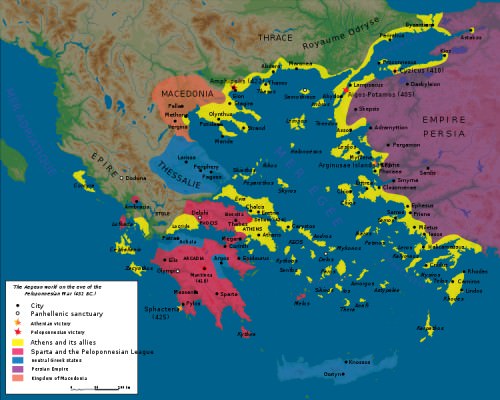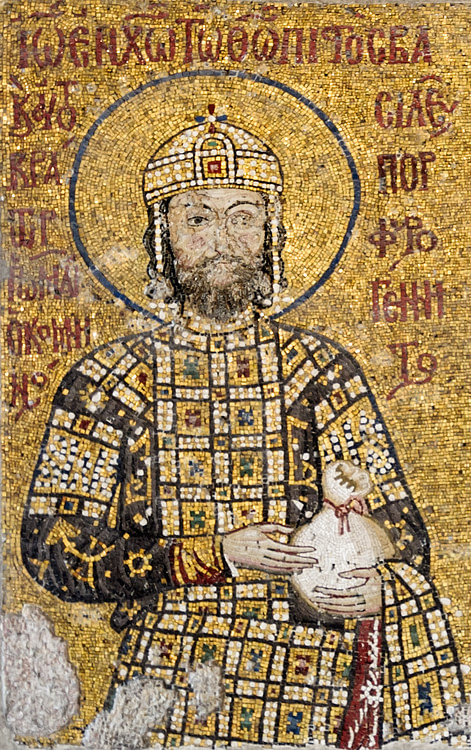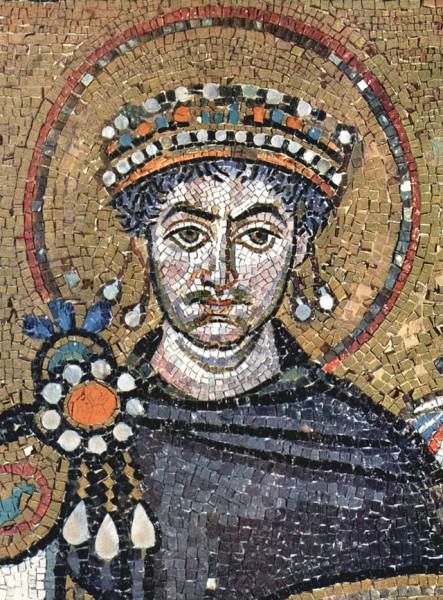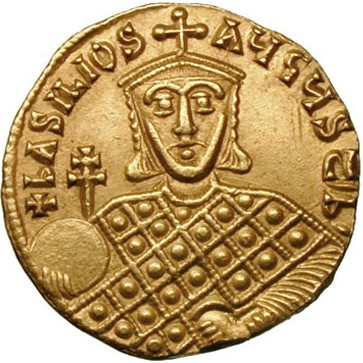The Pentecontaetia › Byzantine Emperor » Ancient origins
Articles and Definitions › Contents
- The Pentecontaetia › Ancient History
- Byzantine Emperor › Antique Origins
Ancient civilizations › Historical and archaeological sites
The Pentecontaetia › Ancient History
Definition and Origins

The Pentecontaetia (Pentekontætia, πεντηκονταετία) or “the account of the fifty years” is a term first used by Thucydides to describe, in Book 1, Sections 89 to 117 (1.89-117) of his History of the Peloponnesian War, the period between the Battle of Plataea in 479 BCE to the start of the Peloponnesian War in 432 BCE. The historian sought to describe how the Athenians “had become so powerful” (1.89.1) and to highlight those key events he believed most alarmed the Spartans and led to the Peloponnesian War. The period is widely considered as the “Golden Age of Athens ” when many of ancient Greece ’s greatest works were produced in architecture, engineering, the arts, history, astronomy, and philosophy.
Thucydides further explains he had also “written about it and have made this digression” to correct the “very brief and inaccurate” chronology of Hellenikos of Lesbos (1.97.2), his contemporary, who wrote the first Atthis or “ local history of Attica.” Thucydides also desired to draw clear distinctions between the “stated reasons” (lit. accusations or complaints) for the war and what he considered the “actual causes” (lit. truest explanation or motive).
Most scholars agree that this section of Thucydides' narrative stood incomplete and unpolished at the time of his death. The only other extant account of this time period, which survives today, remains Diodorus Siculus Book 11, Section 39 to Book 12, Section 28 (11.39-12.28).
DATING THE PENTACONTAETIA
Thucydides begins with the Siege of Sestos (479 BCE) and ends with the Capitulation of Samos (439 BCE), so he covers only 40 years. He had, however, also discussed other events before the digression – such as the Epidamnus Affair, the Corinth - Corcyra Conflict, (435 BCE) as well as the Revolt and Siege of Poteidaia (433/2 BCE). He then describes the entire series of events taking place for “about 50 years” (1.118.2).
THE PENTACONTAETIA BEGAN AFTER THE PERSIAN WARS, WITH AN OFFENSIVE-DEFENSIVE ALLIANCE OF GREEK POLEIS AGAINST PERSIA.
The Pentacontaetia began after the Persian Wars, with an offensive-defensive alliance of Greek poleis against Persia - The Delian League - but, within 30 years, it had morphed into an Athenian Hegemony and then one of Athenian Rule, where the League's resources became focused more on advancing Athenian desires at home and abroad rather than stopping or checking the might of Persia. Scholars typically divide this period into three phases, the first 15 years (479/8-465/4 BCE), the middle 20 years (465/4 – 445/4 BCE), and then the final 15 years (445/4 – 431/0 BCE). They define these phases by known “fixed points,” ie key events we can securely and firmly date, as opposed to clear changes in the direction of historical events.
We mark the end of the first phase with Pausanias (4.24.5) and Diodorus (11.70.1). They each date the Revolt of the Peloponnesian Helots to the 1 st Year of the 79 th Olympiad during the Archonship of Archidemedes. This dating more or less agrees with Thucydides: 465/4 BCE.
We mark the end of the second phase with the Thirty Year's Peace between Athens and Sparta, which, according to Thucydides (1.87.6; 2.2.1, 21.1), occurred in the Winter Months during the Archonship of Kallimachos – with which Diodorus agrees (12.7). Pausanias confirms the date – indicating the Peace took place in the 3 rd Year of the 83 rd Olympiad: 445/4 BCE.
The third and final phase ends with the first invasion of Attica by Sparta, the latter, which Thucydides attests (2.2.1) began the 15 th year of the Thirty Years Peace during the final two months of Pythodorus's Archonship: 431/0 BCE.
Scholars, however, still debate the dates of occurrence and/or the chronological order for many events within each phase, as Thucydides does not in fact provide indicators for the bulk of them. In some cases, he dates events only in relation to other events. For example, we can date the Samian War to 441/0 BCE, since Thucydides tells us it unfolded during the 6 th year of the Thirty Years Peace (1.115.2).

Peloponnesian War
THE KEY EVENTS OF THE PENTACONTAETIA
Scholars occasionally doubt the historicity of some events, most notably the “Peace of Kallias.” They also continually weigh the significance of other events, as well as the significance of several omissions in Thucydides' narrative, such as the Thirty Years Truce between Argos and Sparta. Historians and Classicists must reconstruct a more thorough accounting of the Pentacontaetia using epigraphic evidence (eg The Tribute Lists) and sporadic references to the time period in other authors such as Plutarch and Pausanias or notations made by various ancient commentators.
Scholars typically analyze events of this period topically: the External Policy and Actions of Athens, the Organization and Mechanizations of the Delian League, the Internal History of Athens, Biographical Accounts, and, finally, the Cultural History.
The first phase (479/8-465/4 BCE) includes united – or cooperative – Greek military operations to recover Persian dominated poleis as well as to free areas of Northern Greece and Asia Minor, which includes reducing piracy in the Aegean. It also notes the formation of the Delian League itself to the secession of Thasos. This phase also concerns the rebuilding of Athens' City Walls and beginning construction of walls around Peiraieus. Thucydides also notes the recall of the Spartan Pausanias and the ostracism of the Athenian Themistokles.
The second phase (465/4 – 445/4 BCE) includes the surrender of Thasos, Athenian led operations in Ithome, Tanagra and elsewhere, and the Egyptian Expedition. It also notes the expansion of the League, the relocation of the treasury from Delos to Athens, the “Peace of Kallias,” and the “First Peloponnesian War.” This phase also concerns the building of Athens' Long Walls to Piraeus, the restriction of her citizenship franchise, the establishment of various Athenian settlements, and the construction of the Parthenon. Thucydides also notes the ostracism and subsequent recall of the Athenian Kimon and the rise to prominence of the Athenian Pericles.
The third phase (445/4 – 431/0 BCE) includes Athenian operations against Samos, Pontos, Leukimme, Sybota, and Poteidaia. It also notes the attempt by Athens to institute a single coinage and common system of weights and measures, the foundation of Athenian colonies at Thurii, Amphipolis and elsewhere, and the installing of Athenian Magistrates in Delian League member poleis. This phase also concerns the dedication of Athena Parthenos and the building of the Propylaea.Thucydides also notes the ostracism of his namesake the Athenian Thucydides son of Melesias and the dominance of Pericles in Athenian affairs.

Pericles
The general thrust of Athenian actions during the whole of the Pentecontaetia appeared aimed at establishing some form of political unity and peace for the bulk of the Hellenic world. Athenians used a variety of actions and tools to accomplish this goal: encouragement and enticement, political pressure, treaties, force, garrisons, colonization, suppression of revolts, elimination of local currency, and the unification of laws.
Many Greek poleis came to see Athenian actions as increasingly infringing on both their autonomy and liberty and thus a metamorphosis from a synodic League of equal member poleis to an Athenian Hegemony finally to a collection of mere tributaries under Athenian Rule.
OMISSIONS BY THUCYDIDES
Thucydides, however, remains silent on the great building programs both in Athens and Eleusis and the development and expansion of Athenian festivals, especially the Panathenaia, nor does he mention the transfer of the League treasury to Athens – all of which illustrate clearly how Athenians used League resources more and more to glorify Athens and advance Athenian causes.
Thucydides omits as well several (apparently significant) military operations about the Aegean in addition to saying nothing concerning the establishment of Cleruchies (Athenian settlements on the territory of member poleis ), nor does he cover internal political happenings within Athens between the Persian and Peloponnesian Wars. By the time the war with Sparta began, for example, Thucydides notes elsewhere that the Athenians had come to see they in fact ruled the League as a tyrant (2.63.3).
The Pentecontaetia marks the height of Athenian dominance and culture, which many scholars refer to as the “Golden Age of Athens.” Indeed, many of the ancient Greece's greatest works in architecture, engineering, art, tragedy, comedy, history, astronomy, and philosophy as well as many of the most notable ancient Greek personalities came from Athens during this period.
Byzantine Emperor › Antique Origins
Definition and Origins

The Byzantine Emperor ruled as an absolute monarch in an institution which lasted from the 4th to 15th century CE. Aided by ministers, high-ranking nobility, and key church figures, the emperor (and sometimes empress) was commander-in-chief of the army, head of the Church and government, controlled the state finances, and appointed or dismissed nobles at will. The position was conventionally hereditary but new dynasties would be founded throughout the medieval period.
Living in the sumptuous Great Palace of Constantinople, the emperors enjoyed fabulous wealth but also great risk that, in troubled times, they could be removed by a usurper, imprisoned, blinded, or murdered. Many emperors founded lasting dynasties or achieved even longer-lasting fame as great rulers, and these include Constantine I, Justinian I, Basil I, Basil II, Alexios I Komnenos, John II Komnenos, Constantine VII, and Leo III. Still others gained infamy for their misrule, military incompetence, and bloody reigns: Empress Irene, Nikephoros I, Anastasios I, Constans II, Constantine V, and Leo I.
THE BISHOP OF CONSTANTINOPLE WOULD PRAY OVER THE DIADEM OR CROWN, BLESS THE IMPERIAL INSIGNIA & ANOINT THE EMPEROR'S HEAD WITH MYRRH.
CORONATION
The coronation ceremony of Byzantium developed from the simpler ceremony of ancient Rome where the newly crowned emperor was acclaimed by the army who raised their shields in salute. The military flavour of the ceremony would continue into the 6th century CE but an important and lasting addition was the role played by the Patriarch of Constantinople from the 5th century CE onwards. The bishop would pray over the diadem or crown, bless the imperial insignia, and anoint the emperor's head with myrrh. It became a convention for emperors to crown their heir while still on the throne themselves, in which case they would crown their son, but if the new emperor's father was already dead (or the throne had been usurped) then the bishop laid the crown on the new monarch's head and anointed him with the sign of the cross. When proclaimed emperor, the gathered Byzantine nobility would then bow in homage, the proskynesis.
Within a few centuries, and perhaps in emphasis of the emperor's role as all-powerful, the bishop was relieved of this duty and the emperor crowned himself. This coincided with the moving of the ceremony from the Hippodrome of Constantinople to the Hagia Sophia church from the mid-7th century CE (although empresses were crowned in the Augustaion forum and Church of Saint Stephen). With these two changes, it was made more obvious to all that the emperor was appointed by God. A third connection between the ruler and the church was the often deliberate scheduling of a coronation on an important Christian feast day. Indeed, the whole coronation became a religious ceremony with Holy Communion taken and prayers of blessing said.

Coronation of Theophilos
Besides the crown, the emperor had special robes for the occasion, the long chlamys cloak which was fastened at the wearer's right shoulder. The chlamys would ultimately be replaced by the mandyas, a long cloak fastened at the front of the neck and more closely connected with ecclesiastical costumes.
TITLES, REGALIA & CLOTHING
The emperor was known by several titles over the centuries. As Byzantium was, in effect, the Eastern Roman Empire, the Latin title of imperator was converted to the Greek autokrator. From the 7th century CE the title of basileus, meaning emperor, was adopted instead, actually stolen from Persian rulers. The female equivalent was basilissa. Byzantine emperors jealously guarded their titles and prohibited any foreign rulers from adopting similar ones. Charlemagne, the 8th-century CE King of the Franks, unfortunately, could not be prevented from adopting basileus, and so Byzantine emperors distinguished themselves by extending their own title to basileus ton romaion (Emperor of the Romans)
Aside from his jewel-encrusted diadem and the finery of his embroidered robes, the emperor's regalia included the magnificent jewelled brooch to fasten his cloak. This piece of jewellery was composed of a large central stone set in a circle of smaller ones with three jewels suspended from it. The brooch can be clearly seen in the 6th-century CE mosaic panel depicting Justinian in the Church of San Vitale in Ravenna, Italy. Another piece of the imperial regalia was a gold belt sparkling with gems.
As the nobility became even more garish in their own attire and equipment, so the emperors became concerned that they were not outshone before the public. Justinian I (r. 527-565 CE) even issued a decree that nobody except himself could embellish their belt or their horse's bridle and saddle with pearls, emeralds, or hyacinths. To make sure everyone complied with the new fashion rules, the punishment for ignoring them was death and a fine of 100 lbs of gold. The emperor was also distinct in one other area - the colour of his clothes. Tyrian purple was a dye produced from the murex shellfish, and it took so many shells to produce a decent quantity of dye that it was tremendously expensive.

Justinian I
Purple became even more closely associated with emperors when Constantine V (r. 741-775 CE) added a new chamber to the imperial residence in the Great Palace of Constantinople which was lined with porphyry, a rare purple-laced marble. This room was used thereafter for royal births and gave rise to the phrase porphyrogennetos or “to be born in the purple” meaning the person had a legitimate claim to the throne. Finally, even in death, the emperor was distinguished by being the only person to be buried in a sarcophagus of purple porphyry.
THE PALACE WOULD BECOME A SPRAWLING MAGNIFICENCE OVER THE CENTURIES & INCLUDE A GOLDEN THRONE ROOM & RECEPTION HALLS WITH CLEVER AUTOMATA.
THE IMPERIAL RESIDENCE
For most of the empire ’s history, the official residence of the emperor, his family and court, was the Great Palace of Constantinople. Located along the city ’s sea walls and first built by Constantine I, the palace would become a sprawling magnificence over the centuries and include a golden throne room, reception halls with clever automata of animals and birds, chapels, a barracks, treasuries with booty from all the empire's wars and conquests, sacred holy relics, Roman baths, and fountained gardens. There was a communicating wing which connected the complex to the Hippodrome and a huge monumental gate topped with the largest icon in the city, a golden figure of Christ. Fitted out with exotic marble, fine mosaics, and magnificent statues, the palace was designed to impress locals and foreign visitors alike.
A REMOTE FIGURE
The coronation was the first of the many public events where the emperor would be seen by the people, but the majority of those which followed would be just as carefully orchestrated whether they be appearances in the Hippodrome or audiences granted to visiting ambassadors. Indeed, the accessibility of the emperors would be reduced by this pomp and circumstance, enhancing their image as a unique individual chosen by God to rule the empire. This withdrawal had consequences for government, too, as here described by the historian TE Gregory:
As the emperor withdrew into the narrow confines of palace and court, those who were close to him naturally gained considerable real power, though not always the prestige that went with it. Thus, the members of the emperor's family, especially his wife and mother, and the chamberlains and other domestic servants (who were often eunuchs) gained appreciably in power. They frequently controlled access to the emperor, and individuals who wished to present petitions or seek the ear of the emperor often had first to secure the favor of these influential people (41).
Very few of his subjects might have ever seen the emperor in person, but one thing most people saw across the empire was his image. On coins, medallions, weights, plaques, mosaics, and sculpture, the emperor's likeness was everywhere. Another visible aspect of an emperor's reign was their support for the arts and patronage of scholars. Buildings were erected, old ones refurbished, new manuscripts produced, and lands donated to the church and monasteries. The common people's best chance of catching a glimpse of their emperor was when he rode to church, especially on important holidays like Easter, when traditionally the ruler would throw gold coins into the crowd.

Basil I
GOVERNMENT
The emperor was assisted by various ministers and advisors:
- the quaestor or chief legal officer
- the magister officiorum who looked after the general administration of the palace, the army and its supplies, and foreign affairs
- the cursus publicus who supervised the public post
- the comes sacrarum largitionum who controlled the state mint and supervised customs houses and mines
- the comes rei privatae who looked after the imperial estates
- the Urban Prefect who was, essentially, the mayor of Constantinople
- and the many imperial inspectors who were dispatched to the provinces to make sure laws and policies were being respected there.
Perhaps the most senior figure in the empire besides the emperor and the Patriarch was the Praetorian Prefect of the East to whom all regional governors of the empire were accountable to. The regional governors supervised the individual city councils or curae, but these could directly petition the emperor so that there was both a direct and indirect chain of authority through which imperial policy was transmitted to the ordinary people.
FACES MIGHT CHANGE BUT WHAT WAS MOST IMPORTANT WAS A CONTINUITY OF GOVERNMENT & ECONOMIC & MILITARY SUCCESS.
The emperor's main tool of government besides the individual officials mentioned above was the Senate of Constantinople and particularly the small group of elite aristocrats who made up the Senate's sacrum consistorium. The emperor was, in theory anyway, supposed to consult the consistorium on matters of state importance.
In the 7th century CE, as the empire was increasingly threatened by its neighbours, the Emperor Heraclius (r. 610-641 CE) permanently changed this system so that regional governors - now, in effect, provincial military commanders ( strategoi ) - were directly responsible to and reported to the emperor himself, and the Praetorian Prefect was abolished.

Manuel I Komnenos
CHANGES OF EMPEROR
The Byzantine emperor was considered to have been selected by God to rule the empire and was thus given the right to pass on the role to his male (or even female) children but there were many cases when ambitious military men took advantage of economic strife or a series of military defeats at the hands of foreign powers to seize the throne for themselves by violence.With the backing of the army or a large section of it, such men had the power to halt the dynastic line and start a new one of their own. As the historian C. Mango here summarises, the emperor, and particularly unsuccessful ones, always had to be on the lookout for usurpers:
Of the thirty-nine emperors who ruled between 780 and 1204, nineteen were forcibly deposed, six through outright murder, with another two dying as a result of blinding, the standard method of disqualification. Foul play was suspected in at least three other imperial deaths, and of the hundreds of failed conspiracies and revolts, at least eight posed major military challenges to the incumbent regime. (201)
There was then, a clear ideological separation between the institution of the emperor and the person who actually held the office. Faces might change but what was most important was a continuity of government and, above all, economic and military success. Emperors often used the names which recalled illustrious predecessors, Constantine was adopted by eleven rulers, for example. Customs and traditions were also maintained such as Roman baths, architecture, monumental sculpture, chariotracing, and the use of Latin and Attic Greek, which all helped create the illusion of continuity going back to the earliest Roman emperors of the west. Further, even those who usurped the throne by violent means were almost always high-ranking military men, close to the emperor and familiar with the inner workings of government. Upon acquiring the throne, usurpers very often sought to legitimize their position by marrying a member of their predecessors family and lavishly refurbishing the ancient monuments of their capital. Through this carefully orchestrated continuity, the position of Byzantine emperor was able to resist rebellions, invasions, and sieges so that the institution lasted an astonishing 12 centuries before the empire fell to the Ottomans in 1453 CE.
LICENSE:
Article based on information obtained from these sources:with permission from the Website Ancient History Encyclopedia
Content is available under License Creative Commons: Attribution-NonCommercial-ShareAlike 3.0 Unported. CC-BY-NC-SA License